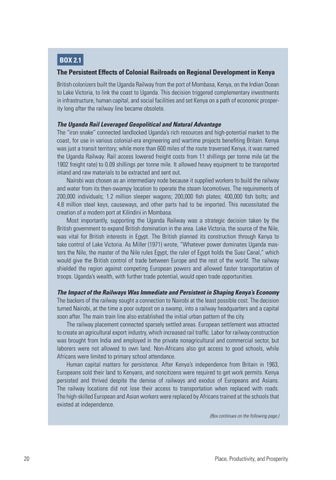BOX 2.1 The Persistent Effects of Colonial Railroads on Regional Development in Kenya British colonizers built the Uganda Railway from the port of Mombasa, Kenya, on the Indian Ocean to Lake Victoria, to link the coast to Uganda. This decision triggered complementary investments in infrastructure, human capital, and social facilities and set Kenya on a path of economic prosperity long after the railway line became obsolete. The Uganda Rail Leveraged Geopolitical and Natural Advantage The “iron snake” connected landlocked Uganda’s rich resources and high-potential market to the coast, for use in various colonial-era engineering and wartime projects benefiting Britain. Kenya was just a transit territory; while more than 600 miles of the route traversed Kenya, it was named the Uganda Railway. Rail access lowered freight costs from 11 shillings per tonne mile (at the 1902 freight rate) to 0.09 shillings per tonne mile. It allowed heavy equipment to be transported inland and raw materials to be extracted and sent out. Nairobi was chosen as an intermediary node because it supplied workers to build the railway and water from its then-swampy location to operate the steam locomotives. The requirements of 200,000 individuals; 1.2 million sleeper wagons; 200,000 fish plates; 400,000 fish bolts; and 4.8 million steel keys, causeways, and other parts had to be imported. This necessitated the creation of a modern port at Kilindini in Mombasa. Most importantly, supporting the Uganda Railway was a strategic decision taken by the British government to expand British domination in the area. Lake Victoria, the source of the Nile, was vital for British interests in Egypt. The British planned its construction through Kenya to take control of Lake Victoria. As Miller (1971) wrote, “Whatever power dominates Uganda masters the Nile, the master of the Nile rules Egypt, the ruler of Egypt holds the Suez Canal,” which would give the British control of trade between Europe and the rest of the world. The railway shielded the region against competing European powers and allowed faster transportation of troops. Uganda’s wealth, with further trade potential, would open trade opportunities. The Impact of the Railways Was Immediate and Persistent in Shaping Kenya’s Economy The backers of the railway sought a connection to Nairobi at the least possible cost. The decision turned Nairobi, at the time a poor outpost on a swamp, into a railway headquarters and a capital soon after. The main train line also established the initial urban pattern of the city. The railway placement connected sparsely settled areas. European settlement was attracted to create an agricultural export industry, which increased rail traffic. Labor for railway construction was brought from India and employed in the private nonagricultural and commercial sector, but laborers were not allowed to own land. Non-Africans also got access to good schools, while Africans were limited to primary school attendance. Human capital matters for persistence. After Kenya’s independence from Britain in 1963, Europeans sold their land to Kenyans, and noncitizens were required to get work permits. Kenya persisted and thrived despite the demise of railways and exodus of Europeans and Asians. The railway locations did not lose their access to transportation when replaced with roads. The high-skilled European and Asian workers were replaced by Africans trained at the schools that existed at independence. (Box continues on the following page.)
20
Place, Productivity, and Prosperity

